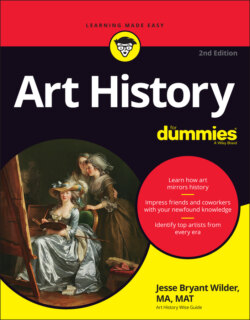Читать книгу Art History For Dummies - Jesse Bryant Wilder - Страница 134
Black-figure and red-figure techniques
ОглавлениеThe Oriental style gave way in the sixth century BC to the even more realistic Archaic style. Archaic-style painters employed one of two techniques, either the black-figure technique, which began in the early seventh century BC, or the red-figure technique, which was invented around 530 BC.
Black-figure vase painting used this technique:
The artist first sketched his figures with a lead or charcoal stick on the red clay vase, and then filled in the figures with slip (a wet clay mixture). When fired, the slip turned black, and the unpainted part of the vase remained red.
Artists often added details with purple or red dyed slip, as in the scene of Hercules slaying the Nemean Lion on the amphora (wine-storing vessel) in Figure 7-9. The shield and dress of Athena — here the divine helpmate of Hercules — illustrates the addition of reddish slip. Note: The guy behind Hercules is his nephew Iolaos, ready with a club in case the lion gives Hercules too rough a time.
Gradually, black figure was replaced by a reverse process known as the red-figure technique, which allowed the artist to create more detailed renderings of figures. In the red-figure technique, the artist
Sketched the figures, and then incised a -inch border around them.
Painted in details with slip (historians aren’t sure how — probably with a fine-haired brush or sharp tool).
Painted the background with slip (which blackened in the kiln) right up to the incised border around the figure.
Andrew R. and Martha Holden Jennings Fund / Cleveland Museum of Art
FIGURE 7-9: The goddess Athena watches Hercules tangle with the Nemean Lion (the first of his 12 labors) on this black-figure amphora, attributed to the Berlin Painter. c. 515–510 BC.
